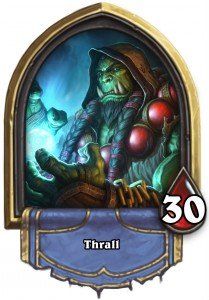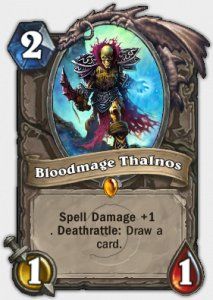
If you've been reading up about Hearthstone, you've probably already seen decks referred to as 'Control', 'Aggro', 'Midrange', 'Combo' and so on. These terms, and others, are broad ways of describing a variety of decks which share similar characteristics and therefore strategies.
How they work is generally fairly self-explanatory, and often the type of deck you're building will become clear as you select the cards and refine them through play testing. However, sometimes you might set out with a specific goal – like creating a Shaman Aggro Deck – in which case all your card choices should be defined by that overall goal.
What's about my curve?
The next important question is what do we want our deck's 'Mana Curve' to look like. This is a complex and well-researched topic in card games, but the simple answer is you want to be able to play something, or be building towards playing something, on every turn. In Control decks, that will often mean spending your mana to respond to minions played by your opponent, so you need to be able to deal with single large minions and lots of little ones. The cards you use to do this are your 'answers'. Aggro decks, in contrast, need to be able to play a 'threat' on every turn in order to maintain constant pressure on the opponent.
Generally, with almost all but the most exotic decks you don't want to waste Mana or turns (although, as with everything in Hearthstone, exceptions exist). Consequently, when creating our deck we must carefully balance the card choices to ensure we're likely to draw a steady stream of playable cards, enabling each turn to flow smoothly into the next. It's not an exact science, but for a balanced deck you should look to include 6-8 cards that cost 2 Mana, 6-8 cards that cost 3 Mana, and 5-8 that cost 4 mana. Your remaining cards can then be made up of very cheap or more expensive options.
What type of cards do I need?
Next we need to consider the balance between types of cards, because the mix of Spells, Creatures, and Weapons (for classes which have them), will greatly affect how you play. Again, the hero you've chosen and the deck archetype you're building will be the major deciding factors. Mages and Druids will always have more spells in their decks than, say, Warriors.

A Mage deck which seeks to stall and control the game until the later stages might run 20-22 spells, whereas modern Zoo decks run as few as 2 spells because they're focused on spamming cheap minions.Weapons are generally very, very good value in terms of Mana Efficiency, because they effectively let you trade your hero's health for minion removal. However, that trade becomes less attractive as the game goes on, which is why Fiery War Axe appears in every Warrior deck, but the more expensive Arcanite Reaper is less common.
Should I pick two of each?
Let's talk a bit about card quality and frequency. The quality of a card should be the primary factor during your initial selection for your new deck. Though it's tempting to pile all your Legendary cards in, the likelihood is an un
PC Gamer Newsletter
Sign up to get the best content of the week, and great gaming deals, as picked by the editors.
balanced deck. Each hero needs to have its best basic cards included – a Druid won't get far without Swipe or Keeper of the Grove , while a Mage will sizzle out without his Fireballs and Mana Wyrms , and a Hunter might as well not exist without Unleash the Hounds .
The question of frequency refers to whether you want the maximum allowable number of a card, or if you want to just run one. There are two reasons you might want the maximum amount of a card: either to increase the speed at which you're likely to draw it, or because the card is so strong that being able to play it twice is desirable and increases the overall strength of the deck. As per the previous examples, Swipe is a case for a card which is so ridiculously strong that it makes sense to have two, while Gadgetzan Auctioneer is so integral to the Miracle Rogue deck that having a pair is essential to ensuring you can use the strategy as quickly as possible.

How much will the deck cost to create?
Finally, we need to decide on a budget for our deck, in terms of the cards we might want to craft using dust. While some players may have access to every card in the game, a lot more people will be just starting out and won't have access to certain key Legendaries that the most popular decks require.
It's important to note that while an expensive Epic or Legendary may improve your deck, if it is thrown in without any consideration, it's just as likely to hurt the performance of the deck. Ragnaros or Bloodmage Thalnos wouldn't do a Zoo deck a whole lot of good, while they would certainly help a Ramp Druid .
For our purposes, we're going to focus on basic cards, with a few commons and rares thrown in. You can either win the dust needed to craft expert cards in the Arena, or get it from disenchanting cards in your collection that you don't want. Alternatively, you can always pick substitute cards with similar stats and effects until you save up the necessary dust.
Remember, a lot of the time a first draft of a deck might not help you surge up the rankings, but don't scrap it after a couple of losses. A tweak here, a tinker there, and the deck may suddenly flourish in ways it didn't before. The main thing is to keep experimenting, and analyzing your games, so you better understand which cards are performing well and which you could switch for more effective alternatives.
Next: Vincent builds the PC Gamer Mage deck
With over two decades covering videogames, Tim has been there from the beginning. In his case, that meant playing Elite in 'co-op' on a BBC Micro (one player uses the movement keys, the other shoots) until his parents finally caved and bought an Amstrad CPC 6128. These days, when not steering the good ship PC Gamer, Tim spends his time complaining that all Priest mains in Hearthstone are degenerates and raiding in Destiny 2. He's almost certainly doing one of these right now.
Most Popular









